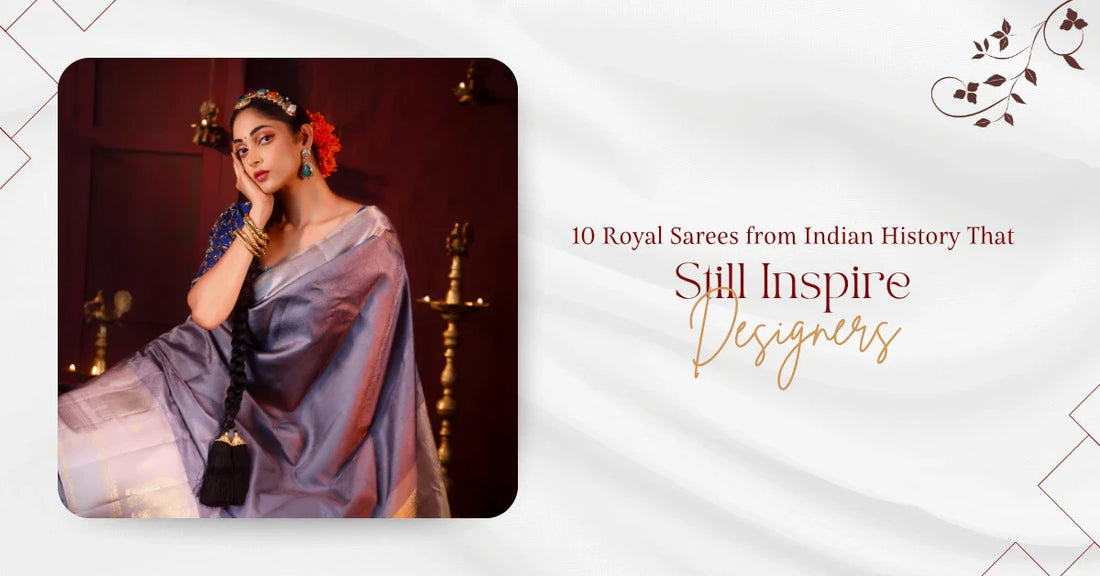10 Royal Sarees from Indian History That Still Inspire Designers
Introduction
In the grand courts of India, sarees weren’t just garments — they were symbols of power, prestige, and artistry. Every dynasty had its signature weave, every queen her preferred drape, and every palace its own palette of colours and motifs. Centuries later, these royal sarees still influence modern fashion, inspiring designers to revive patterns once woven for queens. The shimmer of zari, the depth of hand-dyed hues, and the meticulous detailing of heritage looms remind us that true luxury is crafted, not produced. Let’s explore ten royal sarees from Indian history that continue to inspire designers and embody India’s eternal elegance.
1. The Kanchipuram Silk of the Chola Queens
During the Chola dynasty, Kanchipuram silk emerged as the textile of divinity. Hand-woven from pure mulberry silk and real zari, these sarees reflected temple architecture and Dravidian art.
Modern designers still reinterpret the broad borders and gold checks, paying homage to the craftsmanship that crowned Kanchipuram the “Queen of Silks.”
2. The Banarasi Brocades of Mughal Empresses
The Mughal courts adored the shimmer of Banarasi silk. Crafted with gold-silver zari and Persian-inspired floral motifs, each saree was a tapestry of luxury.
Today’s couture houses re-imagine these patterns in bridal collections, proving that the Mughal romance with silk never fades.
3. The Paithani of the Peshwas
From Maharashtra’s royal heritage comes the Paithani, woven in pure silk with peacock, lotus, and Asawali motifs. Its real-gold threads symbolised prosperity.
Contemporary designers draw from its radiant dual-tone weaves, merging traditional opulence with modern silhouettes.
4. The Patola of the Solanki Queens
Gujarat’s Patan Patola sarees were double-ikat wonders once worn exclusively by royalty. Every pattern was mirrored on both sides, taking months to perfect.
Designers today replicate the intricate geometric and floral patterns digitally, yet nothing matches the charm of hand-tied dyed threads.
5. The Mysore Silk of the Wodeyar Dynasty
Commissioned by Krishnaraja Wodeyar IV, Mysore silk combined simplicity and sheen. Its smooth texture, minimal zari border, and solid colours defined regal understatement.
Even today, luxury fashion borrows from its subtlety — proof that royalty also lies in refinement.
6. The Jamdani of Bengal’s Zamindars
The muslin-fine Jamdani was woven on air, with motifs floating like dreams on translucent cotton. Once prized by Bengal’s zamindars and Mughal courts, it is now protected as a UNESCO heritage craft.
Designers blend Jamdani motifs into organza and chiffon, keeping the delicacy alive in modern couture.
7. The Muga Silk of Ahom Royalty
Unique to Assam, Muga silk’s natural golden glow symbolised purity and permanence. The Ahom queens adorned it during royal ceremonies.
Modern bridal designers admire its durability and sheen — often blending Muga with zari for a golden-hour effect.
8. The Sambalpuri Weaves of Odisha’s Kings
The Sambalpuri Ikat blends tribal symbolism and spirituality. Traditional patterns like shankha (conch) and chakra (wheel) were woven for Odisha’s rulers.
Today’s sustainable fashion designers champion Sambalpuri fabrics for their hand-crafted ethics and cultural storytelling.
9. The Kasavu of Kerala Queens
Minimal yet majestic, Kasavu sarees in white and gold epitomised purity and celebration. The Travancore queens popularised them during Onam and temple festivities.
Designers continue to modernize Kasavu with pastel borders, hand-painted motifs, and fusion blouses for festive collections.
10. The Gadwal Silk of Telangana Royals
Gadwal sarees combine cotton bodies with silk borders — a hallmark of Telangana’s royal taste. Lightweight yet grand, they were the preferred choice for court functions.
Modern interpretations use jewel tones and zari checks, blending heritage with comfort for today’s elegant women.
How Royal Weaves Shape Modern Design
Every designer drawing from Indian heritage — from Sabyasachi to Gaurang Shah — looks to these royal weaves for inspiration. They reinterpret the motifs, drapes, and textures for modern aesthetics while retaining the soul of heritage.
Sri Krishna Silks continues this revival by curating collections that bring royal craftsmanship into every home, honouring India’s past while draping its future.
Conclusion
India’s royal sarees aren’t relics — they’re living legacies woven into every modern design. From the Kanchipuram queens to the Banarasi empresses, each weave embodies power, elegance, and art. Designers may reinvent them, but the soul remains eternal — crafted by hands that knew the meaning of perfection.
At Sri Krishna Silks, we celebrate this royal heritage through exquisite collections that carry centuries of craftsmanship into the present. Because when you wear heritage, you wear history.



